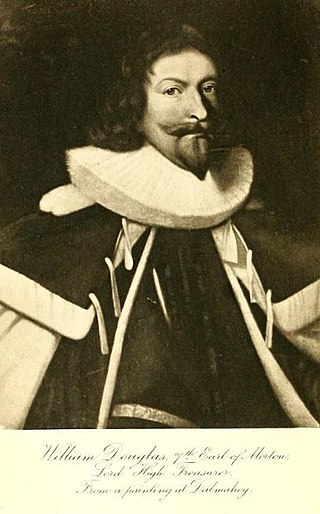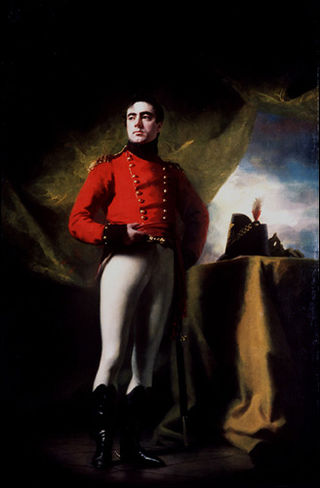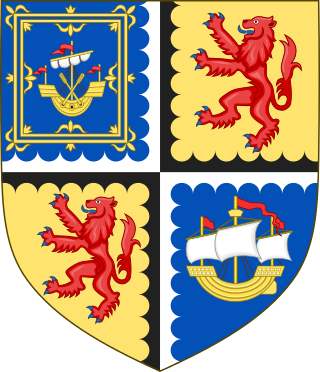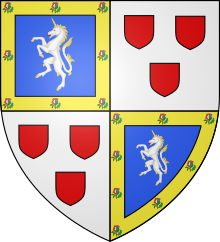
William Douglas-Hamilton, Duke of Hamilton, KG, PC, also known as Lord William Douglas and the Earl of Selkirk, was a Scottish nobleman and politician. He was the eldest son of The 1st Marquess of Douglas by his second wife, Lady Mary Gordon, a daughter of The 1st Marquess of Huntly.
William Sinclair (1410–1480), 1st Earl of Caithness (1455–1476), last Earl (Jarl) of Orkney, 2nd Lord Sinclair and 11th Baron of Roslin was a Norwegian and Scottish nobleman and the builder of Rosslyn Chapel, in Midlothian.

Earl of Kinnoull is a title in the Peerage of Scotland. It was created in 1633 for George Hay, 1st Viscount of Dupplin. Other associated titles are: Viscount Dupplin and Lord Hay of Kinfauns (1627) and Baron Hay of Pedwardine (1711). The former two are in the Peerage of Scotland, while the third is in the Peerage of Great Britain. The title of Viscount Dupplin is the courtesy title for the Earl's eldest son and heir.

William Douglas, 7th Earl of Morton was a grandson of the 6th Earl of Morton. He was Treasurer of Scotland, and a zealous Royalist.

Robert Ker, 1st Earl of Roxburghe was a Scottish nobleman.

Thomas Robert Hay-Drummond, 11th Earl of Kinnoull, styled Viscount Dupplin between 1787 and 1804, was a Scottish peer. His titles were Earl of Kinnoull, Viscount Dupplin and Lord Hay of Kinfauns in the Peerage of Scotland; and Baron Hay of Pedwardine in the Peerage of Great Britain.

George Hay, 1st Earl of Kinnoull, was a Scottish nobleman and political official.

Robert Auriol Hay-Drummond, 10th Earl of KinnoullPC was a Scottish peer and Lord Lyon King of Arms. His titles were Earl of Kinnoull, Viscount Dupplin and Lord Hay of Kinfauns in the Peerage of Scotland and Baron Hay of Pedwardine in the Peerage of Great Britain.

Thomas Hay, 9th Earl of KinnoullPC, styled Viscount Dupplin from 1719 to 1758, was a Scottish peer, British politician, and scholar.
Robert Douglas, Earl of Morton was a Scottish nobleman and Earl of Morton. He was the son of William Douglas, 7th Earl of Morton and Lady Anne Keith, daughter of George Keith, 5th Earl Marischal. In 1627, he married Anne Villiers, a daughter of Sir Edward Villiers.
George Livingston PC was a military officer and third Earl of Linlithgow.

Sir George Hay, 2nd Earl of Kinnoull,, was a Scottish peer, military officer, and political official.

William Thomas Hay, 6th Earl of Kinnoull was a Scottish peer. His titles were Earl of Kinnoull, Viscount Dupplin and Lord Hay of Kinfauns in the Peerage of Scotland.

William Hay, 4th Earl of Kinnoull was a Scottish peer and soldier, loyal to King Charles I. He escaped twice from Edinburgh Castle.

George Hay, 5th Earl of Kinnoull was a Scottish peer and soldier.

William Hay, 1st Earl of Erroll was a Scottish peer. He was the first Earl of Erroll and the second Lord Hay of Erroll.

Andrew Hay, 8th Earl of Erroll was a Scottish nobleman and politician.

John Stewart, Earl of Carrick, Lord Kinclaven was a Scottish nobleman, the third son of Robert, Earl of Orkney, a bastard son of King James V.
William Douglas, Earl of Morton was a Scottish nobleman and Earl of Morton.

George Sinclair was a Scottish nobleman, 6th Earl of Caithness, and chief of the Clan Sinclair, a Scottish clan of the Scottish Highlands.













